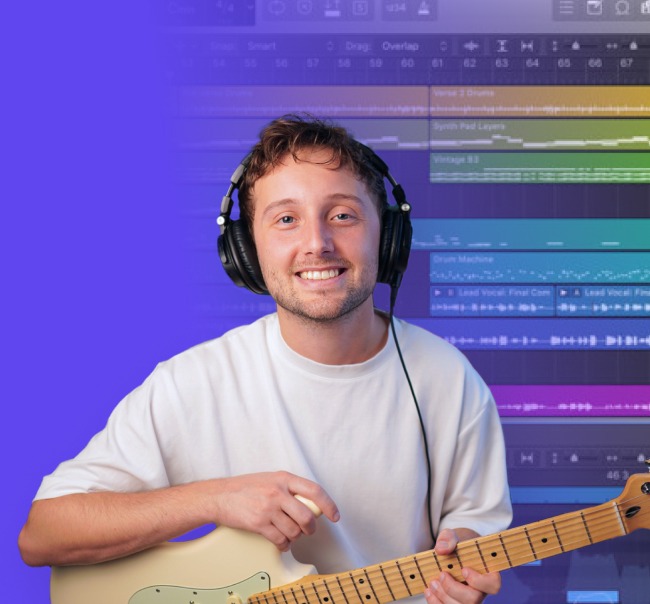
Parts of a Song: How to Use Song Structure In Music
Have you ever wondered how to structure a parts of a song?
There’s so many ways to assemble chord progressions, melodies and rhythms into parts that form a cohesive structure.
And while there isn’t any specific set of rules for structuring a song, it sometimes helps to use a formula when writing a song.
In this guide, we’ll look at every popular song structure and how each part of a song fits within a form.
By the end, you’ll know every kind of song structure and how the intro, verses, chorus, pre-chorus, bridge, and outro fit within a song’s structure.
Theory guides, production tips, new free plugins, gear guides and more—delivered weekly
Keep up with the LANDR Blog.
5 types of song structure
Songs can be structured in a variety of ways.
With a few exceptions, you’ll find that most song structures are defined by the letters A and B denoting different sections.
Or you’ll see the letters V, C, and B used to signify verse, chorus and bridge.
For our purposes we’ll look at the 5 main song structures you’ll find throughout all music:
- AABA
- VCVC
- VCVCBC
- Head-Solo-Head
- Linear or Through Composed
Let’s dive in!
1. AABA
If you’ve ever listened to a classic jazz standard you’ve likely heard this format.
Many legendary composers like Duke Ellington would have used this early song structure in their songwriting.
In AABA, each section lasts exactly eight bars.
Each A section follows a similar chord progression.
The B section will then follow a distinctly different chord progression, up a major or minor third for example.
Often the B section will use a 2-5-1 chord progression to go back to the final A section.
Of course, you don’t have to rigidly follow the eight bar pattern.
It might be nice to extend the B section by an extra eight bars to surprise the listener, for example.
It might be nice to extend the B section by an extra eight bars to surprise the listener, for example.
AABA is a great format to consider if you are writing non-lyrical music, especially jazz.
For an example check out Take the A Train by Duke Ellington,
2. VCVC
Whenever verse and chorus are used in song structure notation the song will contain lyrics.
VCVC is a very simple songwriting structure that features two chorus sections and two verse section.
VCVC is a very simple songwriting structure that features two chorus sections and two verse section.
We’ll dive into the mechanics of verses and choruses later on.
For now, just understand that in a VCVC song structure the chorus sections are the same, while the verse one and verse two will be different from each other lyrically.
Nirvana’s Smells Like Teen Spirit follows a pretty clear VCVC structure, except that the song goes into a final third repetition of the verse and chorus.
The song also features that famous pre-chorus section where Cobain repeats the word Hello.
3. VCVCBC
The only difference between VCVC and VCVCBC is the bridge that comes between the second and third chorus.
In this song structure, an added section is used to bring the song back to the third chorus and remove a possibly repetitive third verse.
You may also see the very similar VCVCBV structure used in many tracks where instead of ending on the chorus, the song ends on an added verse section.
In Weezer’s track Say it Aint So you can clearly hear the bridge before the third and final chorus.
4. Head-Solo-Head
This a very common form found in genres of music that make use of improvisation, especially jazz music.
Head-Solo-Head is a very common form found in genres of music that make use of improvisation, especially jazz music.
Usually, the head section features a recognizable melody from a jazz standard that the band will play together.
This melody in the head section follows a chord progression that is used later on during the solo section.
The solo section can repeat for a very long time– usually long enough for each musician to play a solo.
Solo sections in jazz often culminate with a bombastic drum solo or a period of “trading fours” between each musician and the drummer.
In this case “trading fours” refers to trading solos over four bar sections.
Giant Steps by John Coltrane very much follows this song structure.
5. Linear (through-composed)
Music doesn’t have to follow a repeating structure.
In fact, there’s plenty of great music that follows no structure at all!
Music doesn’t have to follow a repeating structure. In fact, there’s plenty of great music that follows no structure at all!
We can call this kind of song structure linear or through-composed.
You’ll find this structure in lots of classical, ambient, electronic, and experimental music.
Zodiac Shit from Flying Lotus is one example of a song that doesn’t really follow any structure at all.
Introducing… your song!
Now that we’ve looked at the five main song structures, let’s dive into the individual parts of a song.
Most songs start off with some kind of introduction that features an instrument instead of a vocal part.
If you’re writing a pop song, keep in mind that you’ll want to get to the point very quickly. Don’t lose the listener with an overextended intro.
However, if your song doesn’t have to stick to a pop formula, the intro is a good place to set the tone for what the rest your track is going to bring.
Writing the verse
Your verse is where the narrative or story behind your lyrics gets developed.
Your verse is where the narrative or story behind your lyrics gets developed.
A song has to be about something, so your first verse is a great place to introduce the topic.
It’s up to you whether your verses should rhyme or not, but it should at least have a rhythmic meter that pushes the song along.
Typically a verse will last through about eight bars of music.
Warm up the audience with a pre-chorus
Your audience is waiting in anticipation for your chorus.
It’s the most important and memorable part of your track after all.
You can play with that anticipation with a short pre-chorus.
Play with the audience’s anticipation of the chorus with a short pre-chorus.
A pre-chorus might be as short as two bars, but it could be as long as your verse section– it’s up to you.
A recognizable build-up or break down in the pre-chorus can be enough to excite your listeners that the chorus is coming next.
The chorus is the crux of your song
The chorus the part of your song that you want people to remember.
Because it is repeated after every verse, it should be the focal point of your song.
Lyrically you’ll want to deliver your song’s core message in a simple and memorable way.
Traditionally the chorus was intended to be sung along to. Choir and chorus are similar words for a reason.
To make your chorus memorable you need a good vocal hook.
The chorus the part of your song that you want people to remember.
A memorable line of relatable words with a simple melody that anyone can sing along to is a great place to start when writing your vocal hook.
The bridge to somewhere
Knowing when to use a bridge section and what to do with one can be a little bit confusing.
But, in general, you’ll use one towards the end of a song between the last two choruses.
Or sometimes before the last verse if there are three verses.
Knowing what to put in a bridge is another question, there are a lot of things you can do with yours.
Some artists use them to build up towards a final triumphant chorus.
While others will completely deconstruct and rebuild the song.
It’s up to you how you use your bridge, just remember that goal of the bridge is to take the song back to the chorus.
It’s up to you how you use your bridge, just remember that goal of the bridge is to take the song back to the chorus.
Essentially, your bridge must take the listener somewhere musically.
Closing with the outro
Ending a song well can be a little bit tricky.
You could fade out on a studio jam, end on a big chord, abruptly cut the song off, or change the beat completely.
It’s up to you how you end your track, but ending a song memorably is pretty important since it’s the last thing anyone listening will hear.
Don’t forget to put some thought into how the outro wraps up any lyrical or musical aspects of your track too.
Lyrically you may want to end the story your song is telling if the final verse and chorus doesn’t already to that.
Sonically you’ll need to give the impression of finality or depending on the tracklisting within your album, you’ll want the ending to transition nicely into the next song.
Song structure is meant to be broken
As much as they are useful for organizing your songwriting, don’t feel as though anything you write has to follow a rigid formula.
Take the creative license to break from traditional song structures whenever you want.
Your songwriting formula is only good if your track is something that you are proud of.
Gear guides, tips, tutorials, inspiration and more—delivered weekly.
Keep up with the LANDR Blog.




